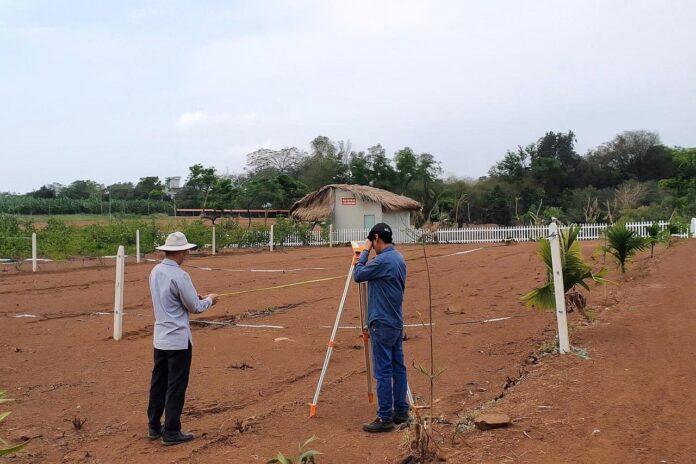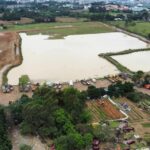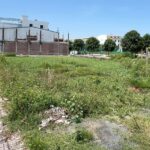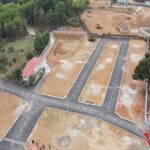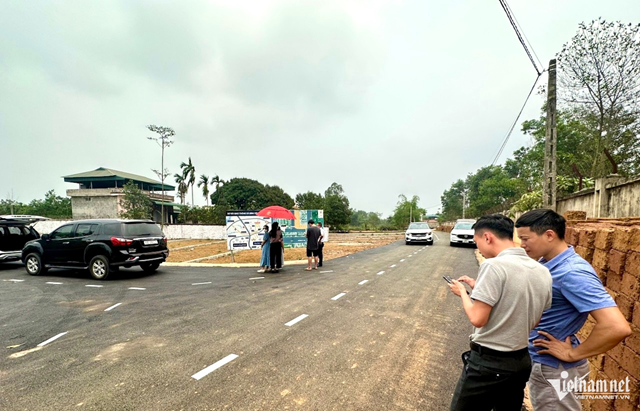
Illustrative image created by AI.
The reason for this is based on Point b, Clause 2, Article 220 of the 2024 Land Law. If the purpose of a portion of the land area is changed, the portion of the land area that is to be changed in purpose must be separated, and the remaining area that is not to be changed in purpose must meet the minimum area requirements as stipulated. Alternatively, Mr. Than must change the purpose of the entire 200 square meters before the application can be accepted. However, Mr. Than only intends to change the purpose of 100 square meters for constructing a house.
Mr. Than asks if the explanation provided by the application-receiving officer is correct.
Response from the Ministry of Agriculture and Environment:
Clause 4, Article 220 of the Land Law stipulates: “4. The People’s Committee at the provincial level shall, based on the stipulations in Clauses 1, 2, and 3 of this Article, other relevant legal provisions, and local customs and practices, formulate specific regulations on the conditions and minimum area requirements for land division and consolidation for each type of land.“
The Ministry of Agriculture and Environment provides this information for Mr. Than’s reference, and suggests that he studies and understands the specific regulations of the locality regarding the conditions and minimum area requirements for land division and consolidation for each type of land. Mr. Than is advised to contact the competent authority in the locality for resolution as per the regulations.
Conditions for Land Subdivision from August 1, 2024
According to Article 220 of the 2024 Land Law, the principles and conditions for land subdivision are as follows:
(1) The land lot must be granted one of the following certificates:
– Land use right certificate
– Certificate of ownership of houses and land use rights
– Certificate of land use rights, ownership of houses and other assets attached to the land
– Certificate of land use rights and ownership of assets attached to the land
(2) The land lot must have a valid land use duration.
(3) The land must not be subject to disputes, seizure for execution of judgments, or temporary emergency measures by competent state agencies.
In cases where there is a dispute over the land, but the disputed area and boundaries can be determined, the undisputed area and boundaries of the land lot may be permitted for subdivision;
(4) The subdivision must ensure access to a passageway and connection to existing public transportation routes. It should also reasonably guarantee water supply, drainage, and other necessary requirements. If the land user allocates a portion of the residential land lot or a portion of the land lot with residential land and other types of land in the same lot for a passageway, it is not mandatory to change the purpose of land use for that portion.
(5) Land lots after subdivision must ensure a minimum area for the type of land being used as stipulated by the People’s Committee at the provincial level.
If the subdivided land lot has an area smaller than the minimum allowable subdivided area, it must simultaneously consolidate with the adjacent land lot.
(6) In the case of changing the purpose of a portion of the land lot, a subdivision must be performed, and the area of the land lot after subdivision must be equal to or greater than the minimum area of the type of land after the change of purpose. For land lots with residential land and other types of land, it is not mandatory to perform a subdivision when changing the purpose of a portion of the land lot, unless the land user requests a subdivision.
(7) In cases where the court’s judgment or decision divides the right to use the land but the division does not meet the conditions, area, and size requirements for subdivision as stipulated, no subdivision shall be performed.
Procedure for Land Subdivision from August 1, 2024
The procedure for land subdivision is stipulated in Article 7 of Decree No. 101/2024/ND-CP as follows:
Step 1: Prepare the application file
The application file for land subdivision includes:
– Request for land subdivision
– Land subdivision drawing
– Granted certificate or certified copy of the granted certificate, along with the original for comparison, or a certified copy notarized by a competent agency
– Documents from competent authorities reflecting the content of land subdivision (if any).
Step 2: Submit the application
The land user shall submit one set of application documents to one of the following agencies:
– One-Door Service Unit as stipulated by the People’s Committee at provincial, district, and communal levels for receiving and processing administrative procedures
– Land Registration Office
– Branch of the Land Registration Office
Step 3: Process the application
– The application-receiving agency shall issue a receipt and schedule an appointment to provide the results to the applicant. If the application-receiving agency is the One-Door Service Unit, the application shall be transferred to the Land Registration Office or its Branch.
– The Land Registration Office or its Branch shall examine the application, compare it with the regulations to determine the conditions for land subdivision, and verify information about the land user, boundaries, area, and type of land from the archived records and the submitted application.
Step 4: Receive the results
In cases of land subdivision without a change in the land user, the Land Registration Office or its Branch shall make adjustments, update changes in the land registry, and the database of land.
Issue the Certificate of Land Use Rights and Ownership of Assets Attached to the Land for the land lots after subdivision, and deliver it to the recipient.
In cases of land subdivision with a change in the land user, perform the procedure for registration of land use right changes, and assets attached to the land as stipulated.
Purchasing Agricultural Land: What to Do When Your Red Book ‘Expires’?
Individuals who directly engage in agricultural production and have been granted the right to use agricultural land within the prescribed allocation limit, even after the initial land use term has expired, are entitled to continue cultivating that land for an extended period of 50 years without undergoing any renewal procedures.
“How to Rezone Agricultural Land for Residential Use”
“The 2024 Land Law sets out a clear framework for converting agricultural land use within residential areas. This process is guided by district-level land-use planning, as well as urban planning regulations approved by the relevant authorities. These plans could be in the form of master plans or sub-zone plans, providing a comprehensive framework for sustainable development.”
“Provincial Chiefs: The New Land Allocators – A Decision-Making Power Shift”
Let me know if you would like me to tweak it or provide other options!
“Addressing the concerns of the business community regarding land-related issues, Minister of Agriculture and Environment, Do Duc Duy, shared insightful news. In a bid to facilitate a more efficient process for businesses, the Ministry is crafting a decree on decentralization and delegation of authority. A key proposal within this decree is to transfer the authority of the Prime Minister to the Provincial People’s Committee Chairmen, a move designed to streamline decision-making and provide much-needed ease to entrepreneurs navigating land matters.”
The Fine Print: 11 Land Use and Rental Fee Waiver Policies Explained
The government seeks feedback from the National Assembly’s Standing Committee on additional cases for land use fee and land rental exemptions and reductions as per the 2024 Land Law.


























